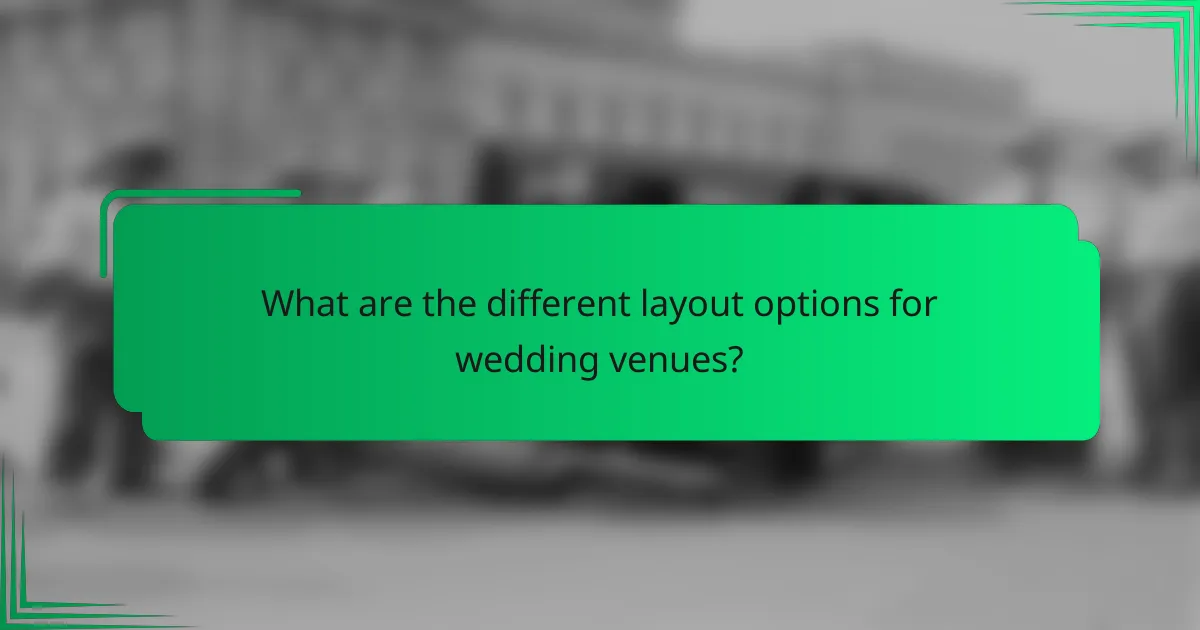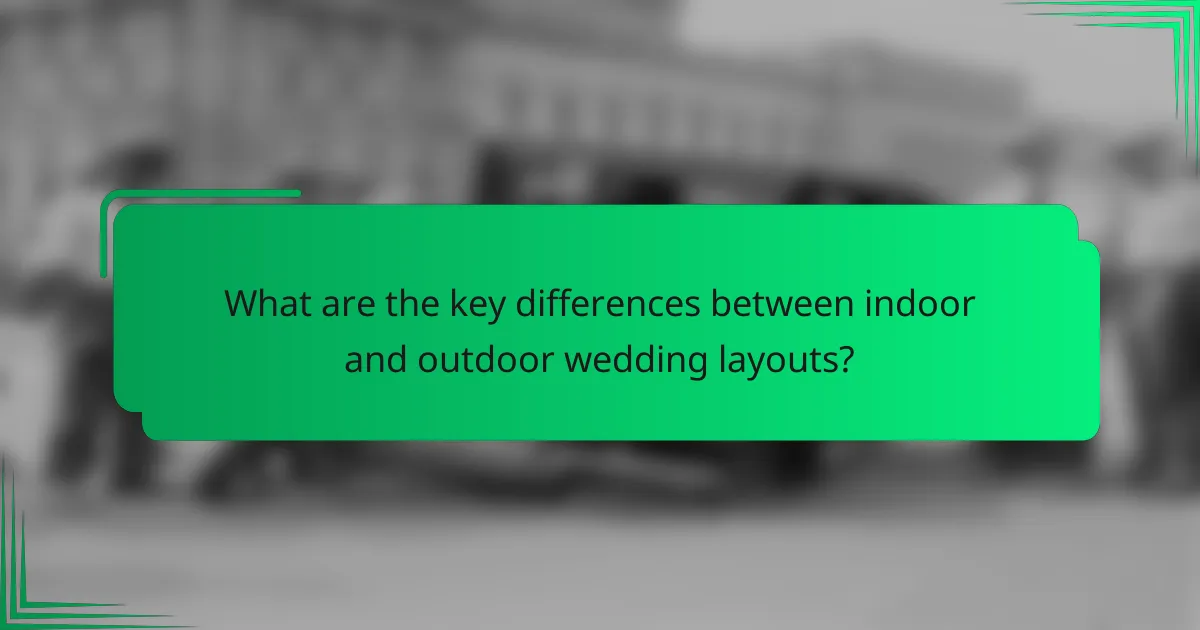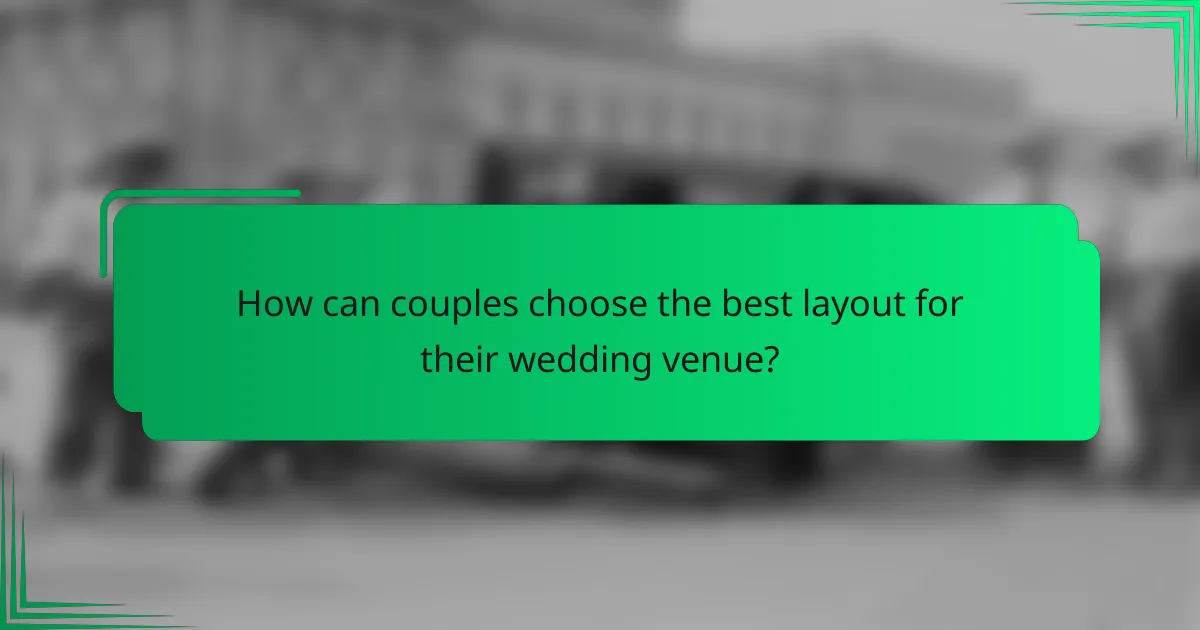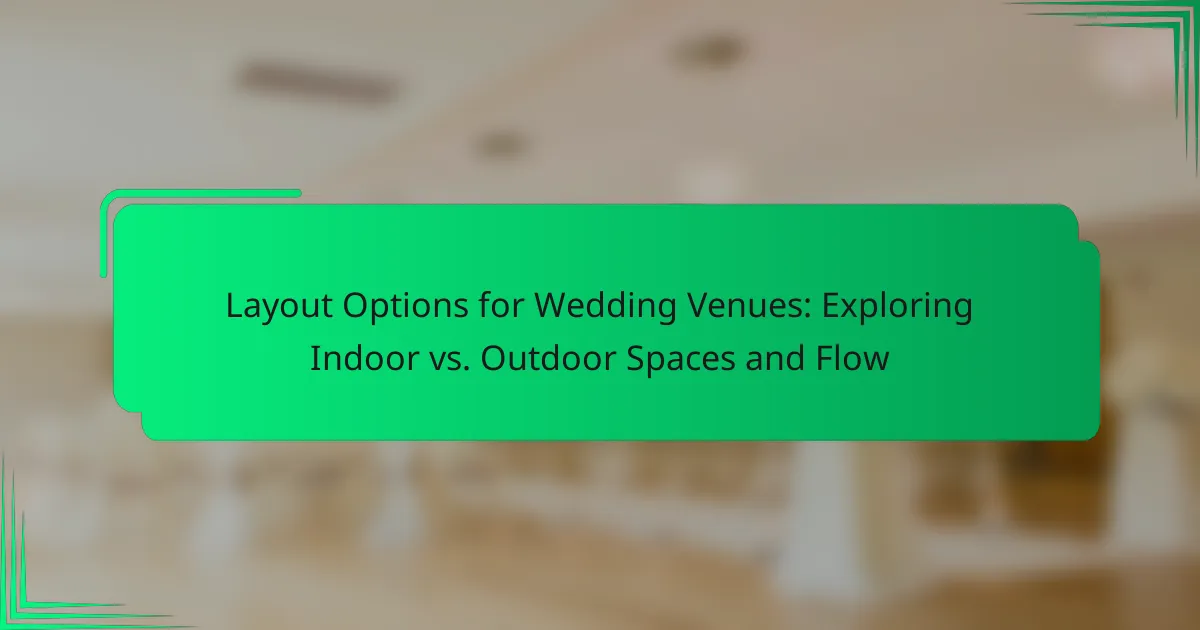Wedding venues present various layout options to enhance the overall experience and accommodate different styles and preferences. The article explores key layout types, including banquet, theater, cocktail, and U-shaped arrangements, highlighting their suitability for indoor and outdoor settings. It discusses how indoor venues provide climate control and structured planning, while outdoor venues offer flexibility and natural ambiance. Couples are guided on selecting the best layout based on guest count, desired atmosphere, event flow, and venue features, with recommendations for consulting professionals to optimize their choices.

What are the different layout options for wedding venues?
Wedding venues offer various layout options to accommodate different styles and preferences. Common layouts include banquet style, which features round tables for dining. Theater style is ideal for ceremonies, providing rows of chairs facing the front. Cocktail style allows for mingling, with high-top tables and no assigned seating. U-shaped layouts facilitate interaction, ideal for small gatherings. Outdoor venues may include garden settings or beachfront arrangements. Each layout enhances the flow and experience of the event, catering to the couple’s vision.
How do indoor and outdoor spaces differ in terms of layout?
Indoor spaces typically have defined boundaries and fixed layouts. They often contain walls, ceilings, and floors that dictate the arrangement of furniture and decor. This allows for controlled environments, facilitating specific designs and themes. In contrast, outdoor spaces are generally open and flexible. They can incorporate natural elements like trees and gardens, allowing for varied layouts based on the landscape. Outdoor layouts are often influenced by weather and terrain, requiring adaptable planning. For example, an outdoor wedding may utilize tents or natural features for seating arrangements. These differences highlight how indoor spaces provide structure while outdoor spaces offer versatility.
What are the advantages of choosing an indoor layout for a wedding?
An indoor layout for a wedding offers several advantages. It provides protection from unpredictable weather, ensuring a comfortable environment for guests. Indoor venues often have climate control, which maintains a pleasant temperature year-round. Additionally, indoor settings can be more easily decorated and customized to fit the couple’s theme.
Lighting can be controlled effectively indoors, creating the desired ambiance. Indoor venues typically have more facilities, such as restrooms and catering kitchens, enhancing convenience. Noise levels can be managed better indoors, allowing for clearer communication during the event.
Moreover, indoor spaces often accommodate larger guest lists without the constraints of outdoor settings. According to a survey by The Knot, 60% of couples prefer indoor venues for these reasons.
What unique features can outdoor layouts provide for weddings?
Outdoor layouts for weddings offer unique features such as natural scenery, flexible space, and fresh air. Natural scenery enhances the visual appeal of the ceremony and reception. This can include gardens, beaches, or mountains, which create picturesque backdrops. Flexible space allows for various setups, such as open-air seating or tented areas. This adaptability accommodates different guest counts and themes. Fresh air contributes to a relaxed atmosphere, promoting comfort and enjoyment. Additionally, outdoor settings often provide opportunities for unique decorations, like floral arrangements integrated with nature. These features collectively enhance the overall wedding experience.
What factors should be considered when selecting a venue layout?
When selecting a venue layout, consider the size and shape of the space. The layout should accommodate the expected number of guests comfortably. Accessibility is crucial for all attendees, including those with mobility challenges. The flow of the event must be intuitive, allowing easy movement between areas. Consider the location of key features such as the dance floor, dining area, and restrooms. Lighting and acoustics impact the atmosphere and guest experience significantly. Additionally, the venue’s style should align with the wedding theme. Finally, consider any restrictions or requirements set by the venue management.
How does guest capacity influence layout choices?
Guest capacity significantly influences layout choices in wedding venues. A higher guest capacity necessitates a more spacious layout to accommodate attendees comfortably. For instance, venues must consider seating arrangements, dance floors, and dining areas based on the number of guests.
Smaller capacities may allow for more intimate settings and flexible layouts. In contrast, larger capacities require careful planning to ensure smooth flow and accessibility. The layout must facilitate movement and interaction among guests, reducing congestion.
Additionally, different layouts may be employed based on the event’s formality and style. For example, a formal sit-down dinner requires different space allocation compared to a casual buffet. Ultimately, understanding guest capacity is essential for creating an effective and enjoyable wedding layout.
What role does the wedding theme play in layout selection?
The wedding theme significantly influences layout selection. A cohesive theme dictates the arrangement of space, colors, and decor. For instance, a rustic theme may require wooden tables and natural elements. Conversely, a formal theme might call for elegant seating and sophisticated decorations. The chosen theme also affects guest flow and seating arrangements. Specific layouts enhance the overall ambiance, aligning with the theme’s aesthetic. Research shows that a well-planned layout can enhance guest experience and engagement, supporting the theme’s vision effectively.
How can the flow of an event be optimized in different layouts?
The flow of an event can be optimized in different layouts by strategically organizing space to enhance movement and interaction. For indoor layouts, creating clear pathways between key areas, such as the entrance, dining, and entertainment zones, minimizes congestion. Utilizing open floor plans allows for flexible arrangements, accommodating various activities without obstruction. For outdoor spaces, incorporating natural pathways and designated zones for different activities encourages smooth transitions. Utilizing elements like signage can guide guests effectively, reducing confusion. Research shows that well-planned layouts can improve guest satisfaction and engagement by 30%.
What are effective strategies for managing guest movement during the ceremony?
Effective strategies for managing guest movement during the ceremony include clear signage and designated pathways. Signage guides guests to their seats and directs them during transitions. Designated pathways minimize congestion and ensure orderly movement. Assigning ushers helps direct guests and maintain flow. Timing is critical; staggering arrival times can reduce crowding. Rehearsing the ceremony with the wedding party ensures everyone understands their roles. Using barriers can create organized spaces and prevent unauthorized access. These strategies enhance the overall experience and ensure smooth movement throughout the ceremony.
How can seating arrangements enhance the overall flow of the event?
Seating arrangements enhance the overall flow of an event by facilitating movement and interaction among guests. Proper layouts ensure clear pathways, minimizing congestion and allowing for smooth transitions between different areas. For example, a circular seating arrangement promotes inclusivity and encourages conversation. Additionally, strategically placed seating can direct attention to key areas, such as the stage or dance floor. Research indicates that well-planned seating can increase guest engagement by 30%. This demonstrates that thoughtful arrangements can significantly impact the event’s dynamics and guest experience.

What are the key differences between indoor and outdoor wedding layouts?
Indoor wedding layouts are characterized by controlled environments, while outdoor wedding layouts rely on natural settings. Indoor venues often provide climate control and protection from weather elements. This ensures comfort for guests regardless of the season. In contrast, outdoor weddings depend on weather conditions, which can affect the event’s flow.
Indoor layouts typically feature fixed seating arrangements and defined spaces for ceremonies and receptions. This allows for more structured planning. Outdoor layouts often require flexible seating and can adapt to the natural landscape. This provides a more open and casual atmosphere.
Additionally, indoor venues usually have lighting and sound systems already installed. Outdoor venues may require additional equipment for lighting and sound. This can involve extra planning and costs.
Overall, the key differences lie in environmental control, layout structure, and equipment needs. Each option presents unique advantages and challenges for wedding planning.
What are the common indoor layout configurations?
Common indoor layout configurations include banquet, theater, classroom, and U-shape. The banquet layout features round tables for dining. This arrangement promotes conversation among guests. The theater layout focuses on rows of chairs facing a stage. It is ideal for presentations and speeches. The classroom layout includes tables and chairs for note-taking. This setup works well for workshops and interactive sessions. The U-shape layout allows for discussion and engagement. It facilitates interaction among participants. Each configuration serves different purposes based on event needs.
How does a traditional banquet layout function for indoor weddings?
A traditional banquet layout for indoor weddings organizes seating around tables to facilitate dining and social interaction. This layout typically features round or rectangular tables arranged to create a central dance floor or focal point. Guests are seated in a way that encourages mingling and conversation, often with the wedding party at designated tables. The layout also allows for clear pathways for service staff to move efficiently. Lighting and decor are strategically placed to enhance the ambiance and highlight key areas. This arrangement supports a structured flow of events, including toasts, speeches, and dancing. Overall, the traditional banquet layout is designed to create an inviting atmosphere for guests while accommodating the various wedding activities.
What are the benefits of a cocktail-style layout indoors?
A cocktail-style layout indoors promotes social interaction among guests. This layout encourages mingling by providing standing tables and open spaces. It fosters a relaxed atmosphere, allowing guests to move freely. The informal setup can enhance networking opportunities. Additionally, it maximizes the use of space, accommodating more guests than traditional seating. This layout often requires less formal dining setup, reducing costs. Studies show that guests prefer environments that encourage movement and interaction. Overall, a cocktail-style layout creates a vibrant and engaging event experience.
What outdoor layout options are popular for weddings?
Popular outdoor layout options for weddings include garden ceremonies, beach setups, and vineyard receptions. Garden ceremonies often feature natural backdrops, such as flowers and trees. Beach setups utilize the ocean as a scenic backdrop. Vineyard receptions take advantage of picturesque grapevines and rolling hills. Other options include terrace layouts with stunning views and rustic barn settings in outdoor spaces. Each layout caters to different themes and preferences, enhancing the overall wedding experience.
How can a garden setting be effectively arranged for a wedding?
A garden setting can be effectively arranged for a wedding by focusing on layout, decor, and accessibility. First, define the ceremony area with a clear focal point, such as an arch or floral arrangement. This creates a visual anchor for guests. Next, arrange seating in a semi-circle or rows to ensure all guests have a good view. Consider the flow of movement by leaving pathways clear for guests to navigate easily.
Incorporate decor elements like string lights or lanterns to create ambiance during evening events. Use natural features of the garden, such as trees and flowers, to enhance the aesthetic. Ensure that the arrangement accommodates weather considerations, providing shade or cover as needed.
Finally, include designated areas for receptions, catering, and dancing, ensuring they are easily accessible from the ceremony site. This arrangement promotes a seamless experience for guests throughout the event.
What considerations are important for a beach wedding layout?
A beach wedding layout requires careful planning to accommodate both the natural environment and the needs of the ceremony. Key considerations include the selection of a suitable location on the beach that offers scenic views and is accessible for guests. The layout should account for wind direction, as it can affect sound and comfort. Seating arrangements must be organized to ensure all guests have a clear view of the ceremony. Additionally, the timing of the ceremony should consider the tide schedule to avoid disruptions. It is important to provide shade options for guests, as beach weddings often occur in sunny conditions. Finally, logistics for sound systems and decorations must be planned to withstand beach elements.
What challenges are associated with each layout type?
Indoor layout types face challenges such as limited space and ventilation. These constraints can restrict guest movement and comfort. Additionally, indoor venues may require extensive decoration to create a desired atmosphere. This can increase costs and planning time. Outdoor layout types encounter issues like weather unpredictability. Rain or extreme temperatures can disrupt events. Outdoor venues may also lack electricity or restroom facilities. This can necessitate additional arrangements, impacting logistics and guest experience. Each layout type presents unique challenges that need careful consideration during planning.
How do weather conditions affect outdoor wedding layouts?
Weather conditions significantly impact outdoor wedding layouts. Rain can necessitate a tent or indoor backup, altering seating arrangements. Wind may require securing decorations and can influence the placement of tables and chairs. Extreme heat can lead to the need for shaded areas or cooling stations. Cold weather might necessitate heaters and blankets for guests. Each of these factors influences the overall design and flow of the wedding layout. Proper planning for these conditions ensures guest comfort and aesthetic appeal. For example, a survey by The Knot found that 30% of couples opt for tents due to unpredictable weather.
What are the logistical challenges of indoor layouts?
Indoor layouts face several logistical challenges. Space constraints can limit movement and accessibility. Poorly designed layouts may hinder guest flow and create bottlenecks. Acoustic issues can disrupt communication and enjoyment. Limited natural light can affect ambiance and visibility. Compliance with safety regulations is essential but can complicate design. Equipment placement must consider power sources and connectivity. Additionally, temperature control can be challenging in enclosed spaces. These factors collectively impact the overall experience and functionality of indoor venues.

How can couples choose the best layout for their wedding venue?
Couples can choose the best layout for their wedding venue by assessing their guest count, desired atmosphere, and flow of events. First, they should determine how many guests will attend. This number influences space requirements and seating arrangements. Next, couples should consider the atmosphere they want to create. An intimate setting may require a smaller, cozier layout. In contrast, a larger venue can accommodate more guests and activities.
Flow of events is also crucial. Couples should visualize how guests will move through the space during the ceremony, reception, and any other activities. Creating a logical flow minimizes congestion and enhances guest experience. Additionally, couples should evaluate the venue’s unique features. Elements like natural lighting, architectural details, and outdoor spaces can influence layout decisions.
Finally, couples may benefit from consulting with venue coordinators or wedding planners. These professionals can provide insights tailored to specific venues and help optimize layout choices.
What questions should couples ask when evaluating venue layouts?
Couples should ask several key questions when evaluating venue layouts. What is the maximum capacity of the venue? Understanding capacity ensures that all guests can be accommodated comfortably. How does the layout facilitate guest flow? Efficient flow prevents congestion and enhances the experience. Are there designated areas for different activities? Specific zones for dining, dancing, and socializing improve organization. What are the accessibility features of the venue? Accessibility ensures that all guests can navigate the space easily. Is there adequate parking available? Sufficient parking is crucial for guest convenience. How does the layout support the desired theme or style? The layout should align with the couple’s vision for the event. Are there options for indoor and outdoor spaces? Flexibility in space choice can enhance the overall experience. What is the proximity of key areas, like restrooms and exits? Close proximity to essential areas improves guest comfort and safety.
How important is accessibility in layout decision-making?
Accessibility is crucial in layout decision-making for wedding venues. It ensures all guests can navigate the space comfortably. This includes considerations for individuals with mobility challenges. According to the Americans with Disabilities Act (ADA), venues must provide accessible routes and facilities. Failure to consider accessibility can limit guest participation. It may also lead to legal repercussions for non-compliance. Therefore, prioritizing accessibility enhances overall guest experience and satisfaction.
What should couples consider regarding layout flexibility?
Couples should consider the adaptability of the venue layout to accommodate different activities. A flexible layout allows for easy transitions between ceremony, reception, and other events. This adaptability can enhance guest experience and comfort. Couples should also evaluate the space for movement and accessibility. Ample space is crucial for guests to navigate comfortably. Furthermore, couples should assess how furniture arrangement can be modified. This can create intimate settings or open areas as needed. Lastly, the venue’s ability to incorporate indoor and outdoor spaces may provide additional flexibility. This option allows for diverse experiences throughout the event.
What are some best practices for ensuring a smooth flow in wedding layouts?
To ensure a smooth flow in wedding layouts, prioritize strategic placement of key areas. Position the ceremony site close to the reception area. This minimizes guest movement and maintains energy. Use clear signage to guide guests between different areas. Signage should be visible and easy to understand. Create defined pathways to avoid congestion. Pathways should lead to food, restrooms, and seating. Consider the timing of events to prevent overlaps. Schedule activities to allow for transitions. Utilize seating arrangements that encourage conversation and movement. Round tables can facilitate interaction, while straight rows may limit flow. Lastly, gather feedback from vendors on logistics. Their experience can highlight potential flow issues.
How can signage and decor guide guests through the venue effectively?
Signage and decor can effectively guide guests through a venue by providing clear directions and enhancing the overall experience. Well-placed signs indicate paths to key areas such as restrooms, dining, and exits. Using consistent visual themes helps guests recognize different sections of the venue. For instance, color-coded signs can differentiate areas like cocktail and reception spaces. Decor elements, like floral arrangements or lighting, can also create visual cues that lead guests along pathways. Research shows that effective wayfinding reduces confusion and improves guest satisfaction. A study by the American Institute of Architects emphasizes that thoughtful design in signage contributes to a positive event experience.
What tips can help couples create a cohesive layout that reflects their style?
Couples can create a cohesive layout by choosing a consistent color palette. This palette should reflect their personal style and theme. Selecting complementary decor elements enhances visual harmony. Incorporating personal touches, like photos or mementos, adds uniqueness. Arranging furniture to facilitate conversation promotes a welcoming atmosphere. Clear pathways ensure smooth flow throughout the space. Finally, cohesive signage reinforces the overall aesthetic. These strategies help in aligning the layout with the couple’s vision.
What common mistakes should be avoided when planning venue layouts?
Common mistakes to avoid when planning venue layouts include neglecting flow and accessibility. Poor flow can lead to congestion, making it difficult for guests to navigate the space. Accessibility issues can exclude individuals with mobility challenges, violating regulations and diminishing guest experience. Failing to consider sightlines can obstruct views of key areas, such as the ceremony or stage. Underestimating the importance of acoustics can result in poor sound quality, affecting communication and enjoyment. Ignoring the venue’s natural light can lead to an uninviting atmosphere, especially for daytime events. Lastly, not accommodating for the number of guests can cause overcrowding or underutilization of space. Each of these mistakes can detract from the overall success of the event.
How can overestimating space impact the guest experience?
Overestimating space can negatively impact the guest experience by creating a sense of emptiness. When a venue is larger than necessary, guests may feel disconnected from each other. This can lead to a lack of intimacy during important moments, such as ceremonies or receptions. Additionally, excessive space can make it difficult for guests to engage with the event. For example, if seating arrangements are too spread out, conversations may be limited. Research indicates that environments perceived as overly spacious can reduce social interaction (Hawkins et al., 2019). Thus, accurately estimating space is crucial for fostering a welcoming atmosphere.
What are the pitfalls of neglecting the flow of an event in layout planning?
Neglecting the flow of an event in layout planning can lead to disorganization and confusion. Poor flow disrupts guest movement and can create bottlenecks. Guests may miss important activities if they cannot navigate the space easily. Inefficient layouts can result in wasted time during the event. This often causes frustration among attendees. A well-planned flow enhances guest experience and engagement. Research shows that effective flow can increase guest satisfaction by up to 30%. Proper layout planning ensures that all areas are accessible and functional.
The main entity of the article is wedding venue layouts, specifically comparing indoor and outdoor options. The article explores various layout configurations, such as banquet, theater, cocktail, and U-shaped styles, highlighting their advantages and challenges. It discusses factors influencing layout selection, including guest capacity, accessibility, and alignment with wedding themes. Additionally, the article emphasizes the importance of optimizing event flow and provides strategies for enhancing guest movement and interaction during ceremonies and receptions. Overall, it serves as a comprehensive guide for couples to make informed decisions about their wedding venue layouts.
